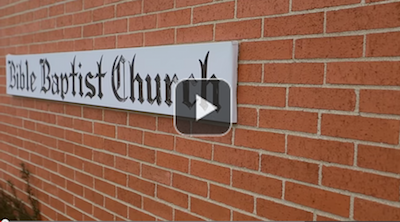OCTOBER 22, 2017
JESUS AND THE MAN BORN BLIND (PART 1 – VERSES 1-12)
INTRODUCTION:
1. Although John gives us some early indications of the unbelieving Jews’ resentment toward Christ, the first phase of their overt hatred began immediately after the notable miracle which He performed on the impotent man in chapter 5.
2. That phase has now been exhausted, and in this chapter another notable miracle is about to produce new hatred and new conflict.
3. Jesus, having avoided the fury of the mob now passes on to the place where He encounters “a man which was blind from his birth.” (Ch. 8:59; 9:1)
4. We will divide this fascinating story into three lessons, under the following three headings:
a) First, the account of the miracle itself,
b) Second, the penetrating investigation which followed, and
c) Third, the record of the spiritual result of the whole matter.
I. FIRST, WE HAVE THE ACCOUNT OF THE MIRACLE ITSELF. (VERSES 1-12)
A. THE PROBLEM OF THIS MAN’S BLINDNESS AND THE REASON FOR HIS BLINDNESS PROVIDE THE SITUATION IN WHICH THE MIRACLE IS WROUGHT. (VERSES 1-5)
1. The disciples apparently took notice of this man because of the way Jesus had looked at him. “Jesus…saw a man which was blind from his birth.”
a) The expression “Jesus saw a man…” indicates something more than a simple notice taken of him.
b) There are many other examples of this truth. (Matt. 9:9; Mark 1:16; 9:20; Luke 7:13; 13:12; John 1:47, etc.)
2. The question of genetic infirmity and divine judgment is raised. (Verse 2) “…who did sin…that he was born blind?”
a) The question implies that sin must be the cause of physical infirmity and suffering.
(1) Of course, in a general sense, this is so. All sickness and infirmity is a result of the fall.
(2) But they were speaking of sin in a specific, personal way.
b) Did this man sin?
(1) In his soul’s preexistence? Were they suggesting such a possibility?
(2) While he was yet in the womb? (Gen. 25:22)
(3) Was this anticipatory chastisement for his future sins?
c) Or did his parents sin? (Exo. 20:5)
3. Jesus’ answer greatly elevates this sad situation. (Verse 3)
a) They had concentrated upon the mystery of suffering.
b) Jesus would have them view the purpose for which God permits suffering and the good that can derive from it.
c) He does not deny sin in this man or his parents.
d) But He does deny a necessary connection between illness and sin.
e) Therefore they have no right to judge the one who suffers.
4. Jesus teaches us that we are to make evil an occasion for good.
a) It is an evil that this man was born blind, yet out of it will come the manifestation of the works of God.
b) The works of God comprehend not only his physical healing, but also his spiritual enlightenment and conversion.
c) The works of God pertain to Jesus and His kingdom.
5. Jesus is the Father’s workman to perform the works of God. (Verse 4)
a) Perhaps Jesus is gazing at the setting sun as He speaks.
b) “The day” is the work of His earthly life.
c) “The night” is the termination of His life by cruel death.
6. While in this world, Jesus is shining as the sun. (Verse 5)
a) While He lives and ministers, the light of His words go forth.
b) While He ministers, there is the opportunity of grace for Israel.
c) When at last they have put Him to the tree, the light will have gone out and they will have been resigned to national darkness.
B. THERE THEN IS THE INTERESTING AND INSTRUCTIVE MEANS BY WHICH JESUS PERFORMS THIS MIRACLE. (VERSES 6, 7)
1. Jesus did not always use the same means to perform miracles.
a) Jesus often healed by a mere look or word. (Matt. 8:8; John 4:49-53)
b) Jesus healed another blind man by a simple touch. (Matt. 20:34)
c) Elsewhere He used spittle only to heal the blind. (Mark 7:33; 8:23)
2. Thus, the means were not essential to the healings, but were used to teach the way of salvation.
a) Negatively, they were not used as a medical agency.
b) Essentially, they were used to bring the sick person into contact with the Person of Jesus in some way.
c) It was necessary that each one knew that the cure came from His very Person.
d) Practically, they teach us that God does use means in salvation.
(1) First, there must be submission;
(2) Next, there must be faith; and
(3) Finally, there must be obedience.
3. The means used here are instructive.
a) The spittle clay reveals the artificial blindness of tradition.
b) The washing itself depicts the Spirit’s regeneration. (Titus 3:5)
c) The pool of Siloam typifies Divine salvation by Messiah. (Isa. 8:6)
(1) Siloam means “sent.”
(2) It’s waters flowed softly.
d) Jesus is “the Sent One” by Whom is salvation.
C. THEN LASTLY, THERE IS THE IMMEDIATE RESPONSE OF NEIGHBORS. (VERSES 8-12)
1. In obedience to Christ, this man is made to see. (Verse 7b)
2. Not finding Jesus, he returns to his home quarters.
3. His neighbors, though amazed, are divided in opinion. (Verses 8, 9b)
4. His simple, direct, and clear testimony is given. (Verses 10, 11)
5. At the mention of Jesus, some want to know where He is.
6. Sensing their animosity, he is glad to say he doesn’t know. (Verse 12)



Speak Your Mind